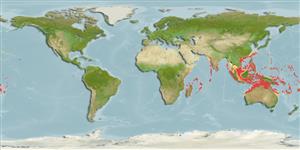Issue
Type locality: Mauritius.
Environment: milieu / climate zone / depth range / distribution range
Ecologia
marinhas associadas(os) a recifes; intervalo de profundidade 4 - 200 m (Ref. 5222), usually 12 - 90 m (Ref. 37816). Tropical; 29°N - 26°S, 38°E - 171°W (Ref. 5222)
Indo-Pacific: east coast of Africa (Zanzibar and Mafia Island, Tanzania) to Samoa, north to Ryukyu Islands, south to Queensland, Australia.
Length at first maturity / Tamanho / Peso / Idade
Maturity: Lm ?, range 67 - ? cm
Max length : 65.0 cm TL macho/indeterminado; (Ref. 48635)
Espinhos dorsais (total) : 9; Raios dorsais moles (total) : 14; Espinhos anais: 3; Raios anais moles: 8. This species is distinguished by the following characters: body oblong, its depth 2.8-3.5 in SL; preopercle rounded, finely serrate, the lower edge fleshy; opercle with 3 flat spines; upper edge of operculum almost straight; rear nostrils not much bigger than anterior nostrils; front of jaws with a pair of large canine teeth; 1-3 large canines at midside of lower jaw; gill rakers of first gill arch 7-9 + 13-16 = 20-25 (including 4 to 7 rudiments on each limb); caudal fin lunate, the upper and lower lobes produced, about twice length of middle rays; pectoral-fin rays 17-19; lateral-line scales 66-76, in series 109-127. Colour of head, body and fins generally reddish with small irregular pale blue to pink spots; 3-4 diffuse pale saddle on back; broad caudal fin usually dusky, with narrow white posterior margin or edge (yellow in V. louti); juveniles similar in colour to adults, but with relatively fewer and larger pale blue or pink spots (Ref. 39231, 89707, 90102).
A generally uncommon species that inhabits seaward reefs (Ref. 9710). Juveniles inshore on algae and soft coral reefs, usually swimming well above the substrate, looking much like a basslet (Ref. 48635). Solitary (Ref 90102) or found in small groups (Ref. 11888). Feeds on fishes. Of little interest to fisheries, because of its small size and rarity, but flesh is excellent.
Caught with handline, traps, and spear (Ref. 39231).
Life cycle and mating behavior
Maturidade | Reprodução | Desova | Ovos | Fecundidade | Larvas
Heemstra, P.C. and J.E. Randall, 1993. FAO Species Catalogue. Vol. 16. Groupers of the world (family Serranidae, subfamily Epinephelinae). An annotated and illustrated catalogue of the grouper, rockcod, hind, coral grouper and lyretail species known to date. Rome: FAO. FAO Fish. Synop. 125(16):382 p. (Ref. 5222)
Categoria na Lista Vermelha da IUCN (Ref. 130435: Version 2024-2)
Ameaça para o homem
Harmless
Utilização humana
Pescarias: pescarias de subsistência
Ferramentas
Relatórios especiais
Descarregue XML
Fontes da internet
Estimates based on models
Preferred temperature (Ref.
123201): 23.9 - 28.9, mean 27.7 °C (based on 1802 cells).
Phylogenetic diversity index (Ref.
82804): PD
50 = 0.7500 [Uniqueness, from 0.5 = low to 2.0 = high].
Bayesian length-weight: a=0.01349 (0.00855 - 0.02128), b=3.07 (2.94 - 3.20), in cm total length, based on LWR estimates for this species & (Sub)family-body (Ref.
93245).
Nível Trófico (Ref.
69278): 4.5 ±0.80 se; based on food items.
Resiliência (Ref.
120179): Baixo, tempo mínimo de duplicação da população 4,5 - 14 anos (Preliminary K or Fecundity.).
Fishing Vulnerability (Ref.
59153): Moderate to high vulnerability (46 of 100).
Nutrients (Ref.
124155): Calcium = 34.1 [19.7, 61.7] mg/100g; Iron = 0.611 [0.316, 1.027] mg/100g; Protein = 18.9 [17.0, 20.6] %; Omega3 = 0.177 [0.114, 0.284] g/100g; Selenium = 49.3 [28.0, 93.9] μg/100g; VitaminA = 83.1 [29.8, 278.9] μg/100g; Zinc = 0.708 [0.473, 1.044] mg/100g (wet weight);
